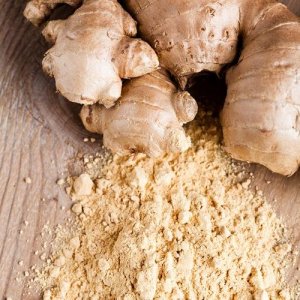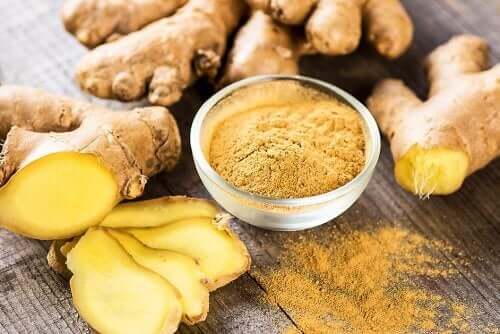The Properties and Uses of Ginger

Knowing the properties and uses of ginger is very helpful. In fact, using this root in the kitchen can bring lots of health benefits. Since it’s full of nutrients, ginger works on lots of parts of the body.
We’ll tell you all about its benefits in this article.
Getting to know ginger
Ginger appeared in Southeast Asia more than 3,000 years ago. It exported to Central Asia in the 5th century BC by the Persian King Darius. In fact, he got it from the Hindu plantations in the Middle East. Confucius’s first data available on the ginger trade tells us how the Phoenicians took it to the Mediterranean. Later, it spread throughout the Mediterranean and the Red Sea.
Although it spread fast after the Roman empire, Marco Polo’s travels exported it to the Americas. Therefore, it now grows wild on the Caribbean Islands. Currently, the main exporter of the best ginger is Jamaica.
The culinary uses of ginger

One of the properties of ginger highlights its powerful ability to enhance flavor. In Asian cuisine, they use it to hide or bring out stronger flavors. Typically, it’s common in oriental cuisine as a flavor enhancer in meat, rice, rice dishes, etc. However, there are an infinite amount of sauces that use this wonderful plant.
For western cuisine, we generally limit ourselves to dry or powdered ginger. This gives the kitchen an exotic aroma. In fact, it can even smell sort of spicy. It’s also great in sweet dishes, biscuits, desserts, caramelized fruits, sorbets, and more.
Discover: Cough Treatment with Black Pepper, Cloves and Ginger
Therapeutic uses of ginger

Traditionally, ginger has been used for stomach conditions and digestive problems. It stimulates the pancreas, so it increases the production of digestive enzymes. Some of the uses of ginger are treating dizziness, vomiting, diarrhea or ulcers.
By stimulating gastric juices, you can use ginger as a pain reliever after meals. Additionally, it will reduce bloating and nausea. Another property of ginger is its anti-inflammatory traits. Therefore, it’s great to treat rheumatic and muscle problems.
Also, it’s one of the best teas for menstrual pain, colds, and mucus issues. Hot ginger mixed with lemon and honey lowers fevers and reduces infections.
Also read: Cream of Vegetables with Mushrooms, Leeks, and Ginger
How to use ginger
To use ginger as a tea to prevent or relieve pain (like menstrual cramps), simply heat four or five slices of fresh ginger root (unpeeled), a tablespoon of lemon juice and some honey. Here’s how:
- Heat water on the stove. When it starts to boil, add the ginger slices.
- Boil it for 10-15 minutes until it turns brown.
- Then, before drinking it, add the lemon juice and honey.
As you can see, there are lots of properties and uses of ginger. You can use it for lots of different reasons, both in treatments or delicious recipes. Give ginger tea a try!
All cited sources were thoroughly reviewed by our team to ensure their quality, reliability, currency, and validity. The bibliography of this article was considered reliable and of academic or scientific accuracy.
-
Cañigueral, S. (2016). Jengibre. OFFARM.
-
Salgado, F. (2011). El jengibre (Zingiber officinale). Revista Internacional de Acupuntura. https://doi.org/10.1016/S1887-8369(11)70041-2.
-
Vásquez R, O., Alenguer, A., & Marreros V, J. (2001). EXTRACCIÓN Y CARACTERIZACIÓN DEL ACEITE ESENCIAL DE JENGIBRE (Zingiber officinale). Revista Amazónica de Investigación Alimentaria.
- Mashhadi, N. S., Ghiasvand, R., Askari, G., Hariri, M., Darvishi, L., & Mofid, M. R. (2013). Anti-oxidative and anti-inflammatory effects of ginger in health and physical activity: review of current evidence. International journal of preventive medicine, 4(Suppl 1), S36–S42
- Nikkhah Bodagh, M., Maleki, I., & Hekmatdoost, A. (2018). Ginger in gastrointestinal disorders: A systematic review of clinical trials. Food science & nutrition, 7(1), 96–108. https://doi.org/10.1002/fsn3.807
This text is provided for informational purposes only and does not replace consultation with a professional. If in doubt, consult your specialist.








